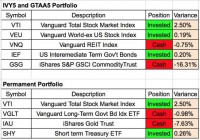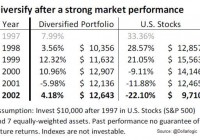Tactical Asset Allocation – August 2015 Update
Here are the tactical asset allocation updates for August 2015. All portfolio updates are online as part of Paul’s GTAA 13 Portfolio New sheet. First, for the basic portfolios – the GTAA5 and the Permanent Portfolio. There was one change in the GTAA5 portfolio. Bonds (NYSEARCA: IEF ) went back to invested this month. GTAA5 is now 60% invested and 40% cash. For the timing version of the Permanent Portfolio there were no changes this month. The TAA version of the Permanent Portfolio is 50% invested and 50% in cash just like last month. Now for the more aggressive GTAA AGG3 and AGG6 portfolios. There are no changes for either AGG3 or AGG6 this month. Notice that the Vanguard REIT Index ETF (NYSEARCA: VNQ ) replaced the Vanguard Intermediate-Term Government Bond Index ETF (NASDAQ: VGIT ) in the top 6 ETFs, but since VNQ is under its 200-day it is not an investable position thus there are no changes from last month for AGG6. AGG6 has only 5 positions like the last 2 months with the rest of the portfolio in cash. Performance for the portfolios so far this year is in the table below. Numbers are for each month. The figures are estimates taken from a variety of sources. I don’t do detailed performance tracking until the end of the year. If you’re a fan of the Antonacci dual momentum GEM and GBM portfolios, GEM continues to be invested in US stocks (NYSEARCA: VTI ), and the bond momentum option of the GBM portfolio continues to be invested in US long-term government bonds (NASDAQ: VGLT ). No changes from last month. I’ve also made my Antonacci tracking sheet shareable so you can see the portfolio details for yourself. That’s it for this month. These portfolios signals are valid for the whole month of August. As always, post any questions you have in the comments. Share this article with a colleague

